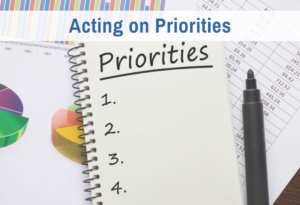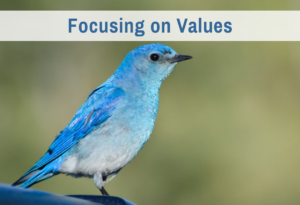For years, I’ve been arguing against a simplistic “just do it” approach to getting things done. That approach uses pressure as the prime motivator. But pressure sabotages your ability to think clearly and creatively. The alternative I developed is self-direction, a method of activating the values you already hold to motivate the action.
The general principle is to ensure all your actions are motivated by love instead of fear. This is necessary if you want to integrate your value hierarchy, reduce internal conflict, and increase your own happiness.
I’ve recently figured out how to “just do it” while staying motivated by love. I call it a “Focus Sprint.” The tactic is inspired by Brooke Castillo’s “Dread Sprint,” but as is usual with me, it reflects my own particular take on the process — including a new name focused on values!
What a “focus sprint” is
A “focus sprint” is a defined period of time — roughly 45 minutes to 2 hours — during which you commit to working on an important goal that you are having trouble putting time on. For this period of time, you commit to tolerating more unpleasantness and conflict than your usual limit. This will require you to expend noticeably more energy and effort managing your motivation. You therefore plan on being drained at the end of the sprint, just as you would if you were running a 100-yard dash.
The critical difference between a 75-minute focus sprint and pressuring yourself to “just do it” for 75 minutes is that you maintain emotional self-awareness and manage your motivation consciously.
In contrast, pressure, by its nature, reduces self-awareness. In fact, pressuring yourself to work nonstop for 75 minutes is easier than doing a focus sprint. The pressure blocks out awareness of the unpleasantness and conflict. That makes it easier to concentrate and “just get it done.” The problem with this approach is that by suppressing those feelings, you literally reduce your long-term awareness of your own values and your short-term awareness of darn good reasons you shouldn’t be doing this right now. This leads to self-induced stupidity, burnout, hating your work, and tremendous difficulty resolving internal conflicts — all of which sabotage your happiness.
In contrast, a focus sprint fuels your short- and long-term happiness.
Why you might need focus sprints
Because they take so much effort, I don’t recommend you just start doing focus sprints. For most of your work, rational goal-setting and self-direction will be sufficient to help you concentrate and motivate action. Those processes are fundamental to maintaining a value orientation. They are also easier and more pleasurable than a focus sprint. They are designed to reduce the effort it takes to get clear payoffs for all of your work. Moreover, if you consistently set rational goals and use self-direction to pursue them, over time you will integrate your value hierarchy and build long-term happiness. Some people may never need to add “focus sprints” into their productivity toolkit.
You need focus sprints if you have ambitious goals that require you to develop significant new values.
For example, to create a successful business, you need to love your product, love solving problems, love developing business processes, love managing people, love marketing, and love making money. Add to that, love raising money if your startup needs outside investors. Most entrepreneurs hold only some of those values at the start. They need to develop significant new values.
The same kind of thing happens on a smaller scale when you get promoted beyond your current skillset. If you’re a techie promoted to a management job, you will need to learn to love managing people to succeed. It even happens when you embark on your dream. I’ve coached retirees who are finally able to work on their novels, but to succeed, they need to learn to love the writing, editing, and marketing.
In other words, ambitious goals require that you develop strong new values in kinds of work that you might currently feel aversion to doing. Therefore, when you set a new ambitious goal, you can create a chicken-and-the-egg problem because you don’t yet have strong enough values to motivate action. Goal-directed action is the primary way to develop and strengthen your values, but to ensure your long-term happiness, all action should be motivated by existing values!
If you have enough time, you can still use self-direction to call on existing values to motivate action, thereby setting up a virtuous cycle of success, which eventually strengthens all the values over the long term.
But if you have an ambitious goal, you need to accelerate this process of value strengthening. And that means you need a way to take action first without so much overhead to lure yourself into it. A focus sprint is a way to do that. It will jumpstart building values, relying on skills to ensure you keep taking steps and do not suppress your feelings — including lots of negative feelings — while also ensuring your action pays off with “strategic byproducts” no matter what.
Steps for a focus sprint
There are three critical steps to make sure a focus sprint is doable and pays off:
1) Decide ahead of time what you will be doing and when.
When you start work on a new goal, there can be many options for how to proceed. As a business owner, you could offer many different products and you could advertise in many different ways. As a writer, you could write many different articles. As a manager, you could learn many different kinds of people skills and take many different kinds of steps to help your team succeed.
You need to start somewhere. You start by picking one and getting into action. You need to just pick one because as a novice, you likely don’t yet know enough to choose the best option.
Making a decision and following through is necessary from a value-strengthening perspective. Indecision gets you nowhere. It prevents action. Plus, it does not reprogram your value hierarchy! If you keep thinking about a project rather than take action to make it a reality, you will eventually lose motivation and trigger guilt and frustration. So from a psychological perspective, it is urgent to get into action sooner rather than later, even if you don’t yet know the best option.
You need to decide ahead of time and stick with it because you will likely want to second-guess your decision for what to do on a sprint. That is counterproductive. So you go into the sprint knowing that you may feel some doubts, but you do it with the certainty that it is better to follow through, build some values, and learn from the experience. That will make the next steps and the next decisions easier.
This is why you need to prepare yourself for unpleasantness and conflict. You will still doubt your decisions and feel a pull to second-guess them. You may need to use self-direction repeatedly to defuse such doubts and keep yourself in action. All of the benefit of a focus sprint comes from the doing. So keep the deciding to a minimum, and stick with your decision.
2) Double-down on self-direction.
To make the sprint palatable, you need to rededicate yourself to the process of self-direction. If you find the work difficult, you need to break down the task into next physical actions. Before you take each action, you need to identify the payoff you are working toward — one that you believe you can get and that is meaningful to you. If you have any hesitation, you need to create positive urgency by reminding yourself why you want to change the status quo.
In particular, you need to get creative in identifying payoffs for what you’re doing. It is all too easy to turn a focus sprint into the drudgery of “just do it.” The difference is that in a focus sprint, you see selfish values you are sure to get right now. Those may be “strategic byproducts” such as, “I’m learning the tools of marketing,” or “I’m practicing being outside of my comfort zone,” or “I’m getting important information about what people are or are not interested in.” The thing you can guarantee is self-development, i.e., you will grow your knowledge or skills or self-understanding. When you identify that explicitly up front — and you believe that this self-development is critical to achieving your ambitious goal — then self-development gives you an extra source of pride, joy, and confidence while you are stumbling along a rocky road without the experience to make it easy and comfortable.
As I said, this takes extra mental effort. It means there is an extra overhead in everything you do in a focus sprint. You may need a deliberate warm-up of your mental circuits. You may need to take 3-minute walks. You may need to use all of the tactics in the Thinker’s Toolkit at one time or another. It will take dedication and energy — but it won’t require you to force your mind or suppress anything.
3) Celebrate, celebrate, celebrate, plus mourn if necessary.
Perhaps the most important part of a focus sprint is the end, when you do celebration and mourning.
Make sure you celebrate all of your achievements. Celebration is the deliberate identification of values you have gained by an activity. If you put your mind to it, you can always find many things to celebrate. I was speaking recently with a client who had created his first-ever video describing his product for his home page. We spent a solid 5 minutes listing all of the good things that came out of it. This included a celebration of how professional it came out, a celebration of all of the tools he had researched and learned in order to do it, a celebration of how it was relatively easy once he got over the hump, and a celebration that this marked a big step in his business.
You can celebrate even in a failure.There is always something you learned or can learn from an ostensible failure. But if you do fail, it’s important to mourn the losses. This helps you get clearer on the values lost. By taking failure seriously, you can strengthen the values you are pursuing, you can strengthen your trust in yourself, and you can strengthen your commitment to finding a creative way to gain your values.
And finally, celebration ensures you end on a positive note and file your focus sprint as a success. Even if you had a miserable slog for your 75 minutes and did not accomplish what you had hoped to accomplish, you did some important things. Perhaps you clarified the problem. Perhaps you got clearer on the motivation that is holding you back. Perhaps you demonstrated conclusively that the task you picked is not the thing to do first. All of these are collateral gains that deserve to be celebrated as part of a focus sprint. You went into it knowing it would be difficult, knowing it might not be successful, knowing that you would learn something. Harvesting that learning is part of the process. And so is patting yourself on the back for having followed through on your decision, even though it was difficult. That takes courage and integrity, and you are reinforcing those deep values every time you do a focus sprint.








0 Comments